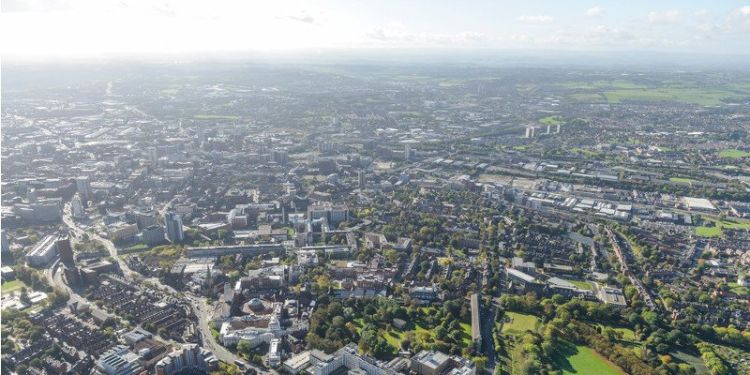Research spotlight: Self-repairing cities

Self-repairing cities
Dr Raul Fuentes, Associate Professor in Infrastructure Engineering at the School of Civil Engineering and an Honorary Lecturer at UCL, is Co-director of the pioneering EPSRC-funded Self Repairing Cities project.
What’s the project all about?
The project aims to tackle the Grand Challenge of Zero disruption from streetworks in UK cities by 2050.The research team’s vision is to develop robots that will identify, diagnose and repair streetworks through minimally invasive techniques in three main areas:
‘Perch and Repair’ – drones performing repairs, such as remote maintenance
‘Perceive and Patch’ – swarms of flying vehicles for autonomous inspection, diagnostics, repair and prevention of highway defects (e.g., potholes)
‘Fire and Forget’ – hybrid robots designed to operate indefinitely within live utility pipes performing inspection, repair, metering and reporting tasks.
Not included in this project, but part of the overall infrastructure robotics vision are these other three areas:
‘Construct and Confirm’ – coordination of robot teams to build/print, finish and certify infrastructure from CAD models, using environmentally friendly building materials
‘Plunge and Protect’ – autonomous robots with the ability to perform under water for underground infrastructure inspection repair, and preventive defect maintenance
‘Dismantle and Dispose’ – advanced manipulation in extreme environments to manipulate, cut, separate and unfasten structures (e.g., nuclear de-commissioning).
The project is being developed from a holistic angle. The impact of technology and how it serves people will be a priority. Although the technology will be developed to ensure the best possible robots are created to maintain infrastructure, the focus will be on how people both now and in the future will be affected. Zero disruption means better air quality, fewer delays, less material and resource use.
'Our current approach to maintenance and repair is disproportionate to the problems themselves. For example, pot holes could be repaired when they are millimetres thick but at the moment they are often left undetected and then they can cause big problems. Repairing them takes a lot of energy in terms of materials and people power. Plus, potholes themselves and their repairs put lives at risk. Our repair intervention needs to be carried out in line with the problem. We need to capture early. We need to capture before the problem is visible to the naked eye. We can do that with robots.’ Raul Fuentes
How’s the project funded?
A £4.2 million grant received from the Engineering and Physical Sciences Research Council (EPSRC) in 2016 has helped get the project off the ground. It forms part of the £21 million funding for ‘Engineering Grand Challenges’ research which aims to tackle some of the major challenges facing science and engineering.
Who’s involved?
The first project of its kind in the world sees partnerships with academics from the following universities:
- University of Leeds
- UCL
- University of Southampton
- University of Birmingham.
There will also be significant interdisciplinary contributions from across the University of Leeds itself with researchers from:
- School of Civil Engineering
- School of Mechanical Engineering
- School of Electronic and Electrical Engineering
- School of Computing
- Leeds University Business School
- School of Environment
- Institute for Transport Studies.
Additionally, Leeds City Council is providing an in-kind contribution of up to £5 million by allowing the research team to use the city as a ‘Living Laboratory’, providing data and access to resources. Safety within the city will be paramount so the team will also work in partnership with Leeds City Council and the UK Collaboration for Research in Infrastructure and Cities (UKCRIC) to ensure that the robots are rigorously tested before being responsibly and safely trialled in Leeds.
What impact is the project expected to have?
Although in its early days, it’s anticipated that this project will have a far-reaching impact in the following ways:
- improving the health, wellbeing, happiness and economic prosperity of people living within cities by reducing the impact of infrastructure engineering on natural systems
- stimulating UK research in the area of future cities through exploring the concept of sensing and automated repairs
- developing technologies for autonomous defect detection and diagnosis compatible with new and existing infrastructure.
With help from Leeds City Council, the research team hopes to make Leeds the first city in the world that is fully maintained autonomously by 2035.
How will the team work?
The team will take a tri-fold approach to the project:
- developing technologies for autonomous defect detection and diagnosis compatible with new and existing infrastructure resulting in minimally invasive sensing and repair
- developing robotic platforms, control strategies, sensing and communication systems to autonomously undertake minimally invasive infrastructure management in complex city environments
- understanding and managing the interactions between our technology, our society and the ecological environment.
'We don’t need to overcomplicate things. We want to have the stupidest robot that can do the job, not the smartest. That minimises the things that can go wrong.' Raul Fuentes
Student education
We typically offer undergraduate students the opportunity to work on research projects related to this theme and based on ability, to become part of the team.
Want to find out more? Visit the self-repairing cities website.

